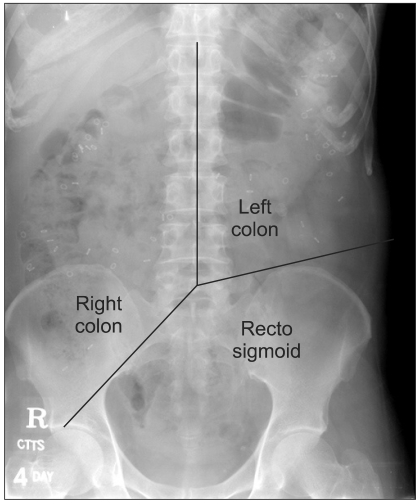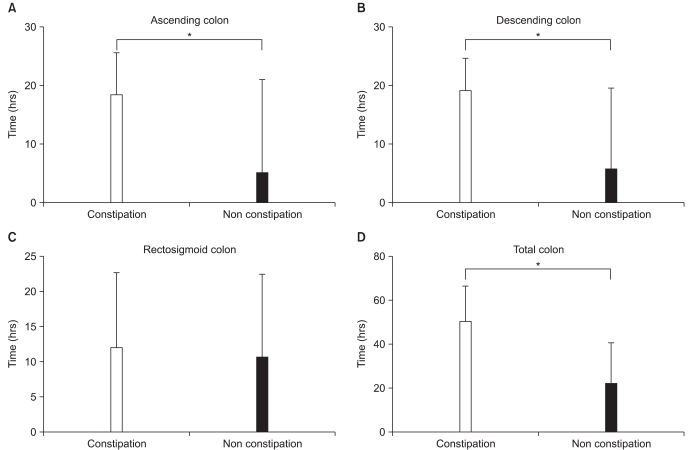Ann Rehabil Med.
2011 Jun;35(3):337-343. 10.5535/arm.2011.35.3.337.
Bowel Function in Acute Stroke Patients
- Affiliations
-
- 1Department of Rehabilitation Medicine, Asan Medical Center, University of Ulsan College of Medicine, Seoul 138-736, Korea. mhchun@amc.seoul.kr
- 2Department of Rehabilitation Medicine, University of Jeju College of Medicine, Jeju 690-121, Korea.
- 3Department of Rehabilitation Medicine, Philip Hospital, Seoul 138-170, Korea.
- KMID: 2266852
- DOI: http://doi.org/10.5535/arm.2011.35.3.337
Abstract
OBJECTIVE
To investigate factors related to bowel function and colon motility in acute stroke patients. METHOD: Fifty-one stroke patients (29 males, mean age 63.4+/-13.6 years, onset 13.4+/-4.8 days) were recruited and divided into two groups: constipation (n=25) and non-constipation (n=26) groups. We evaluated the amount of intake, voiding function, concomitant swallowing problem and colon transit time (CTT) using radio-opaque markers for ascending, descending and rectosigmoid colons. The Adapted Patient Evaluation Conference System (APEC), Korean version of Modified Bathel Index (K-MBI) and Motricity Index (MI) were evaluated.
RESULTS
The constipation group showed significantly prolonged CTT of ascending, descending and entire colon (p<0.05) and more severe swallowing problems (p=0.048). The APEC scale (2.65+/-1.44 vs 1.52+/-0.92, p=0.001), K-MBI scores (59.4+/-14.4 vs 28.0+/-24.3, p<0.001) and MI scores (69.1+/-22.3 vs 46.8+/-25.9, p=0.001) of the constipation group were significantly lower compared to the non-constipation group.
CONCLUSION
Our study demonstrated that bowel function in acute stroke patients was associated with functional status and swallowing function, indicating the need for intensive functional training in post-stroke constipation patients.
Keyword
MeSH Terms
Figure
Cited by 2 articles
-
Bowel Dysfunction and Colon Transit Time in Brain-Injured Patients
Yu Hyun Lim, Dong Hyun Kim, Moon Young Lee, Min Cheol Joo
Ann Rehabil Med. 2012;36(3):371-378. doi: 10.5535/arm.2012.36.3.371.Diagnostic Value of Plain Abdominal Radiography in Stroke Patients With Bowel Dysfunction
Hyo Jeong Moon, Se Eung Noh, Ji Hee Kim, Min Cheol Joo
Ann Rehabil Med. 2015;39(2):243-252. doi: 10.5535/arm.2015.39.2.243.
Reference
-
1. Scivoletto G, Fuoco U, Badiali D, Braccl F, Lucente LD, Patrelli A, Vona VU, Tnillo D, Castellano V, Corazzian E. Gastrointestinal dysfunction following stroke. J Neurol Sci. 1997; 150:S151.2. Robain G, Chennevelle JM, Petit F, Piera JB. Incidence of constipation after recent vascular hemiplegia: a prospective cohort of 152 patients. Rev Neurol. 2002; 158:589–592. PMID: 12072827.3. Harari D, Norton C, Lockwood L, Swift C. Treatment of constipation and fecal incontinence in stroke patients: randomized controlled trial. Stroke. 2004; 35:2549–2555. PMID: 15486330.4. Krogh K, Christensen P, Laurberg S. Colorectal symptoms in patients with neurological disease. Acta Neurol Scand. 2001; 103:335–343. PMID: 11421845.5. Roth EJ. Medical complication encountered in stroke rehabilitation. Phy Med Rehabil Clin North Am. 1991; 2:563–578.7. Bracci F, Badiali D, Pezzotti P, Scivoletto G, Fuoco U, Di Lucente L, Petrelli A, Corazziari E. Chronic constipation in hemiplegic patients. World J Gastroenterol. 2007; 13:3967–3972. PMID: 17663511.8. Garrigues V, Bau I, Bastida G, Galvez C, Ponce J. Concordance between rome and rome II criteria for chronic constipation, a population-based study. Gastroenterology. 2001; 120:A634.
Article9. Demeurisse G, Demol O, Robaye E. Motor evaluation in vascular hemiplegia. Eur Neurol. 1980; 19:382–389. PMID: 7439211.
Article10. Korner-Bitensky N, Mayo N, Cabot R, Becker R, Cooperismith H. Motor and functional recovery after stroke: accuracy of physical therapists' predictions. Arch Phys Med Rehabil. 1989; 70:95–99. PMID: 2644920.11. Su Y, Zhang X, Zeng J, Pei Z, Cheung RT, Zhou QP, Ling L, Tan J, Zhang Z. New-onset constipation at acute stage after first stroke incidence, risk factors, and impact on the stroke outcome. Stroke. 2009; 40:1304–1309. PMID: 19228840.12. Metcalf AM, Phillips SF, Zinsmeister AR, MacCarty RL, Beart RW, Wolff BG. Simplified assessment of segmental colonic transit. Gastroenterology. 1987; 92:40–47. PMID: 3023168.
Article13. De Looze DA, De Muynck MC, Van Laere M, De Vos MM, Elewaut AG. Pelvic floor function in patients with clinically complete spinal cord injury and its relation to constipation. Dis Colon Rectum. 1998; 41:778–786. PMID: 9645749.
Article14. Choi H. Measurement of Colon transit time. Korean J Gastrointest Motil. 1999; 5:198–206.15. Belsey J, Greenfield S, Candy D, Geraint M. Systemic review: impact of constipation on quality of life in adults and children. Aliment Pharmacol Ther. 2010; 31:938–949. PMID: 20180788.16. Lehmann JF, DeLateur BJ, Fowler RS Jr, Warren CG, Arnhold R, Schertzer G, Hurka R, Whitemor JJ, Masock AJ, Chambers KH. Stroke rehabilitation: outcome and prediction. Arch Phys Med Rehabil. 1975; 56:383–389. PMID: 809023.17. Jongbloed L. Prediction of function after stroke: a critical review. Stroke. 1986; 17:765–776. PMID: 3526649.
Article18. Skilbeck CE, Wade DT, Hewer RL, Wood VA. Recovery after stroke. J Neurol Neurosurg Psychiatry. 1983; 46:5–8. PMID: 6842200.
Article19. Rao SS, Sadeghi P, Beaty J, Kavlock R, Ackerson K. Ambulatory 24-h colonic manometry in healty humans. Am J Physiol Gastrointest Liver Physiol. 2001; 280:G629–G639. PMID: 11254489.20. Min KC, Chong SY, Chung JS. A survey of defecation pattern after discharge in stroke patients. J Korean Acad Rehabil Med. 2000; 24:388–394.21. Nino-Murcia M, Stone JM, Chang PJ, Perkash I. Colon transit in spinal cord-injury patients. Invest Radiol. 1990; 25:109–112. PMID: 2312245.22. Lim SS, Choi KH, Myung SJ, Sung IY. Evaluation of the neurogenic bowel by colon transit time and anorectal manometry in the spinal cord injured patients. J Korean Acad Rehabil Med. 2001; 25:249–255.23. Del Giudice E, Staiano A, Capano G, Romano A, Florimonte L, Miele E, Ciarla C, Campanozzi A, Crisanti AF. Gastrointestinaal manifestations in children with cerebral palsy. Brain Dev. 1999; 21:307–311. PMID: 10413017.24. Park ES, Park CI, Cho SR, Na SI, Cho YS. Colonic transit time and constipation in children with spastic cerebral plasy. Arch Phys Med Rehabil. 2004; 85:453–456. PMID: 15031832.
- Full Text Links
- Actions
-
Cited
- CITED
-
- Close
- Share
- Similar articles
-
- Treatments to Promote Neural Repair after Stroke
- General Management of Acute Stroke
- Organization of Stroke Care System: Stroke Unit and Stroke Center
- Coagulation-Fibrinolysis system in acute progressive and non-progressive stroke: Preliminary study
- Pneumococcal meningitis complicated by otomastoiditis and pneumocephalus confounding an acute ischemic stroke diagnosis



